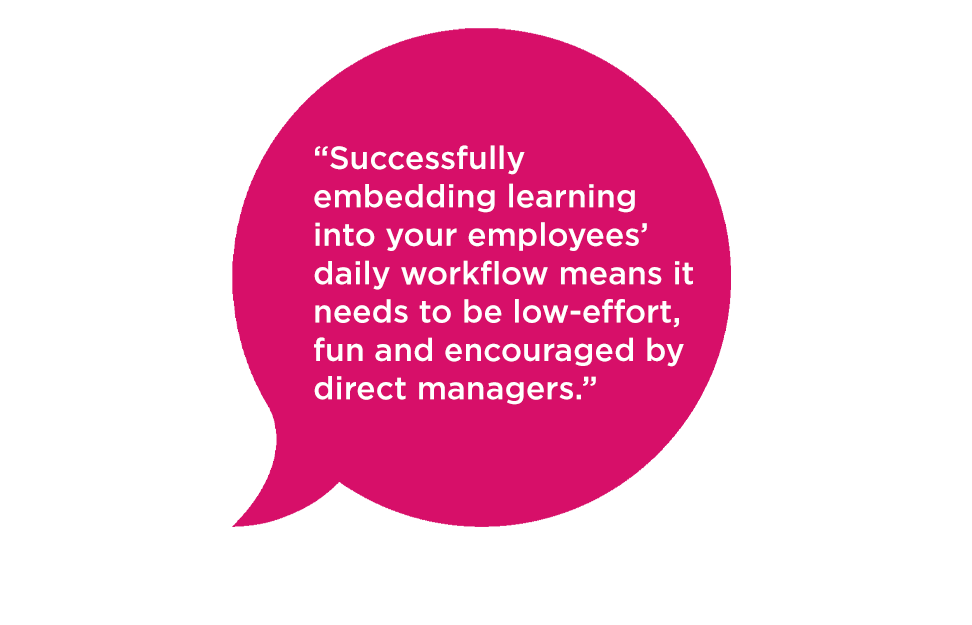
Combatting the ‘forgetting curve’ for our frontline bankers
By Justin Schakelman, Director of Learning and Leadership Development, Citadel Credit Union
When people call or come into a credit union, they usually have a purpose, whether it’s an urgent need, a question or a challenge they need to solve. And they always have expectations for their experience. They want helpful, knowledgeable service that accurately addresses their need. That’s why it’s crucial for employees providing in-person service to be ready with sharp skills and flawless knowledge.
Effective ongoing training that scales
At Citadel Credit Union, our branch staff are critical to providing in-person, specialized member service. They need to be well-versed and confident in our products and services, core banking platforms, sales and management and leadership. In addition to routine transactions, Combatting the ‘forgetting curve’ for our frontline bankers they have to stay up to date with the less-frequent—but still very important—types of requests.
When branch staff have the knowledge they need, they can give our members accurate, timely advice that helps them find the product or service to fit their needs. This impacts our net promoter score (NPS) and has other trickle-down effects on our brand and the communities in which we operate.
As we grow, Citadel needed a way to efficiently deliver continuous training to frontline branch staff to help them retain the information they need to deliver exceptional customer experiences.


Tackling big goals with frontline-first learning
I joined Citadel in 2018 as the Director of the Learning & Leadership Development, a business unit that’s responsible for new hire onboarding and ensuring our retail frontline workers have the skills and behaviors they need to be successful.
As I performed my due diligence on the training pain points at Citadel, I noticed that all teams shared a common challenge around effectively engaging employees in ongoing training. In the past, training at Citadel was straightforward: we taught a skill, and we tested employees on that skill. Once they passed the test, they were sent out into the world, and we expected them to always use that skill competently and confidently. As we grew, we needed an efficient way to keep that information top of mind, to combat the natural human tendency to forget.
While I pushed for change in the organization, I educated stakeholders on the idea of ‘the forgetting curve’ and how it affects performance. The idea that employees will naturally forget information—unless it’s regularly reinforced—seemed obvious. Our old approach didn’t help our bankers commit skills to long-term memory. We needed a more scientific approach.
Selling leadership on the science, not the product features
We needed a repetitive, consistent, fact-based learning approach that required little effort and fit unobtrusively into a frontline employee’s daily workflow. That meant embracing microlearning. Microlearning isn’t just the length of a training video or module.
That’s certainly part of it, but it’s also about the spaced repetition of information. At my previous organization, a Fortune 100 financial institution, I ran a controlled study of microlearning, and that’s when Axonify first showed up on my radar. Axonify uses concepts like spaced repetition and gamification to engage frontline workers. Its machine learning and algorithms serve up relevant, tailored, meaningful question sets to people within their everyday workflow. Axonify was just what Citadel needed to keep our bankers engaged in continuous learning.
Rather than pitch a solution right away, I began to sell management on the idea of microlearning. By getting everyone on board with effective learning science behind the platform, I could explain the behaviors that we needed to build into our organization. By doing so, we’d help our people learn what they needed—and get that learning to stick in the long run.
Once we were aligned on the idea of microlearning and the retention science behind it, I was able to then make the business case to begin due diligence with a number of vendors. Axonify won out due to their science- and data-driven approach to microlearning, which was more elegant than the other platforms we explored.

The experiment that achieved a 24% sales increase
We did a controlled experiment with Axonify over a period of seven months with a narrow focus on credit card sales. Historically, when our system showed that a member was eligible for a credit card, the banker would present the offer.
But, if the member said they weren’t interested, the conversation would end there. This pattern meant our bankers struggled to hit their targets for cross-selling credit cards. We were missing out on sales opportunities.
If a member refuses the offer, our bankers should know various ways to handle any objections or indifference. They should know the features and benefits of the credit card to demonstrate its value. We used Axonify to reinforce knowledge, skills, and behaviors to properly sell the card to a member. By using Axonify to strengthen those behaviors, we saw a 24% increase in credit card sales compared to the control group.
There were some other valuable relationships among the data, too. One correlation suggested that bankers who used microlearning frequently are much more likely to cross-sell more credit cards compared to those who didn’t use microlearning as often. That gave us the validation we needed to scale Axonify to all of our retail frontline employees.

Analyzing the gaps and uncovering opportunities
When Citadel launched Axonify two years ago, it was ‘optional’ learning for employees. As such, we saw a consistent 50% adoption rate. The regular users loved the gamification, the competitiveness, the points that can be cashed in for merchandise, and themed team competitions.
When we looked further into adoption rates, we found there was a strong correlation between employee use and their manager’s use. In other words, if an employee’s manager didn’t use Axonify, they probably didn’t either. So, we started running competitions connected to branch KPIs and broadcasted the results in a compelling way. Adoption rates leapt as high as 90% at one point in the heat of a big competition.
We’re now averaging a 75% participation rate when we run competitions. And, while we’re pleased with this number, there’s still opportunity to get better. Participation is something that we continually review, and regularly working with managers to reinforce the importance of daily learning in Axonify is key. We’re on the hunt for topics that will resonate well with people and, most importantly, drive business KPIs.
Toward that end, we quantify the impact of our microlearning strategies using Axonify’s Impact Engine. Since we feed our actual sales production numbers into the platform, it’s able to correlate sales performance with an employee’s use of Axonify.In one scenario, for example, we saw that 30% of a person’s ability to sell well was due to the knowledge and skills they’ve honed using Axonify.
That’s the kind of strategic business intelligence that helps us support the value of Axonify, and we will work to build out more of that every year. We’re also working on a strategy to marry Axonify’s data with our LMS data, which incorporates machine learning, advanced analytics, and artificial intelligence to recommend timely and relevant training aligned to business KPIs.
The power of compounded learning
We’ve seen positive short-term results, but you must take the long view with microlearning. You need to be committed to actively managing your L&D strategy, rather than taking a “set it and forget it” approach. This is an active platform that delivers better results the more you work at it. There are no shortcuts.
When selling the idea of microlearning to Citadel, I set the expectation that we had to play the long game to realize the full and significant impact of our effort. Axonify has demonstrated the importance of approaching employee development in new and different ways.
At Citadel, we’re okay with trying something different, to innovate and create new opportunities for folks to perform better. We’re willing to invest in our frontline in small ways every day so that we can all reap the long-term benefits.

